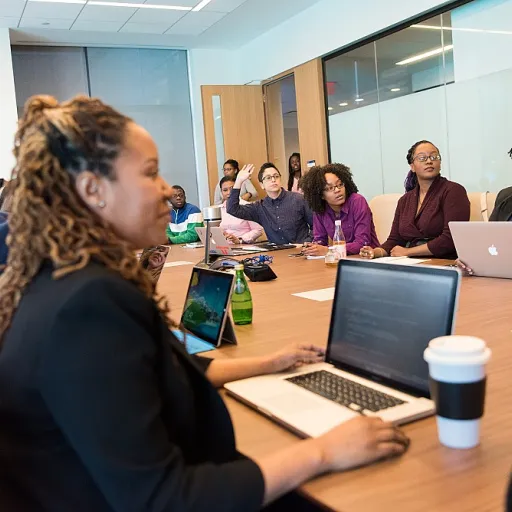
Understanding the Evolving Landscape of Work
Unveiling the Shifting Dynamics of the Workplace
The nature of work is undergoing a transformation, characterized by rapid change and adaptation. With the rise of remote work environments and the integration of new technologies, organizations are tasked with the challenge of reshaping their communication strategies to align with this evolving landscape. As organizations strive to stay competitive, the importance of effective communication planning cannot be overstated. This involves crafting a communication plan that is not only efficient but also resonates with the target audience. Ensuring internal communications are clear and engaging is essential for maintaining employee engagement and facilitating change management. Understanding this shifting environment is pivotal. Insights into how communication strategies influence organizational success provide a blueprint for adapting to these changes. As businesses navigate this transition, the role of communication becomes central to corporate engagement strategies, highlighting the need for tailored communication efforts. Corporate leaders and communication managers should focus on strategies that incorporate current best practices and leverage modern communication channels such as social media to reach their audience effectively. The planning process should be comprehensive, addressing both internal and external communications with a keen understanding of the nuances associated with a diverse workforce. For those interested in delving deeper into the nuances of this transforming work environment, the article on exploring the depth and breadth of the future of work offers valuable insights and perspectives.Identifying Key Organizations for Effective Communication
Recognizing Major Influencers in Communication Planning
The evolving landscape of work demands understanding and adaptation from various organizations. In the planning process of communication strategies, different organizations play a crucial role. Let's delve into identifying some of these key players.
Corporate organizations, with their established structures and vast employee base, are at the forefront of shaping communication strategies. Their role is vital in ensuring effective communication and engagement within teams. These entities must design communication channels that address the needs of a diverse workforce, thereby boosting employee engagement and management.
- Corporate Organizations: They need to focus on internal communications to streamline operations while adhering to best practices for effective communication.
- Social Media Platforms: These channels facilitate an audience-driven approach, enabling organizations to reach a wider audience efficiently.
- Consultancies and Think Tanks: Organizations should collaborate with these entities to gain valuable insights into emerging communication strategies and change management.
As organizations navigate the shifting dynamics of the workforce, a strategic communication plan becomes non-negotiable. Insight from diverse organizations enriches the planning process, leading to comprehensive strategies that address both practical challenges and long-term organizational goals.
Role of Technology Companies in Communication Planning
Technology Companies: Pioneers of Effective Communication Strategies
In the modern era, technology companies play an integral role in communication planning for future work environments. Their influence extends through the development and implementation of tools that are crucial for fostering effective communication in organizations. As work landscapes evolve, these companies are at the forefront, driving changes and providing valuable insights into successful communication strategies.
Organizations should consider the following aspects where technology companies contribute significantly:
- Innovative Communication Channels: Technology companies continuously develop platforms that enhance communication, such as social media and collaboration tools. These platforms serve as essential channels for internal communications and employee engagement, enabling seamless interaction across various departments and roles.
- Change Management Support: As experts in adapting to fast-paced environments, technology firms offer software solutions that aid in change management. This is crucial for organizations aiming to maintain effective engagement with their employees during transitions or transformations.
- Insights and Analytics: By providing analytical tools, these companies equip organizations with the capability to analyze and refine their communication efforts. Understanding the effectiveness of a communication plan is essential for tailoring strategies that resonate with the target audience.
- Paper-Free Solutions: With an increasing trend towards reducing physical paperwork, technology companies offer software that supports paper-free communications, thus promoting sustainability and efficiency in corporate environments.
The collaboration between technology companies and organizations is vital for ensuring effective communication planning. Through a blend of innovative solutions and strategic insights, these companies help shape the future of workplace communication. For further exploration on how technology is shaping the workplace, you can read more in this comprehensive overview.
Human Resources Firms and Their Influence
The Strategic Role of Human Resources Firms in Communication
In the constantly evolving landscape of work environments, human resources firms play a pivotal role in communication planning. Their unique position allows them to integrate communication strategies that cater both to organizations and their employees. Such firms provide valuable insights into employee engagement, ensuring that the communication efforts are effective and well-received.
An essential part of the planning process involves understanding an organization's target audience. Human resources firms specialize in translating this knowledge into internal communications that resonate with employees. This understanding is crucial as it informs the management on how to address the diverse needs of their workforce, enabling a more cohesive environment where change is embraced and effectively managed.
Furthermore, with the growing trend towards paper-free operations, human resources firms are increasingly turning to digital channels to facilitate best practices in communication. Social media and communication channels like employee apps are essential tools that organizations should consider integrating into their strategy. These tools not only enhance the speed of information dissemination but also support real-time feedback, vital for change management.
Ultimately, the role of human resources in communication strategy is to bridge the gap between organizational goals and employee needs. This not only aids in planning but also ensures a robust communication plan is in place. Their insights help shape strategies that are not only focused on the present but are equally concerned with the future, making them indispensable allies in effective communication planning.
Educational Institutions as Communication Catalysts
Educational Institutions as Catalysts for Effective Communication
In the rapidly evolving landscape of work, educational institutions play a pivotal role in shaping communication strategies. These organizations are not just about imparting knowledge; they are becoming key players in communication planning by equipping future employees with the skills needed for effective communication in corporate environments.
Educational institutions are increasingly focusing on integrating communication skills into their curricula. This ensures that graduates enter the workforce with a solid understanding of communication channels and strategies. By doing so, they help bridge the gap between theoretical knowledge and practical application, which is crucial for effective communication in any organization.
Moreover, these institutions often collaborate with technology companies and human resources firms to provide valuable insights into the latest communication trends and best practices. This collaboration is essential for developing communication plans that are both innovative and practical, addressing the needs of a diverse target audience.
Another significant contribution of educational institutions is their role in change management and employee engagement. By offering courses and workshops on these topics, they prepare future employees to handle organizational changes effectively, ensuring smooth transitions and maintaining high levels of engagement.
In summary, educational institutions are not just passive participants in the planning process. They actively contribute to shaping communication strategies that are crucial for the success of any organization. Their efforts in fostering a deep understanding of communication dynamics among students are invaluable for ensuring effective communication in the workplace.
Collaborative Efforts for Comprehensive Planning
Fostering Collaborative Communication Strategies
In the rapidly changing landscape of work, collaboration is key to developing effective communication strategies. Organizations should focus on creating a comprehensive communication plan that integrates insights from various sectors. This approach ensures that communication efforts are not only effective but also inclusive of diverse perspectives.
One of the primary roles of collaboration in communication planning is to bring together different stakeholders. This includes technology companies, human resources firms, and educational institutions. Each of these players offers unique insights that can enhance the planning process. For instance, technology companies provide the tools and platforms necessary for modern communication channels, while human resources firms contribute valuable insights into employee engagement and change management.
Educational institutions play a crucial role as communication catalysts. They help bridge the gap between theoretical knowledge and practical application, ensuring that communication strategies are grounded in research and best practices. By involving educational institutions in the planning process, organizations can access a wealth of knowledge that can inform their communication strategy.
Moreover, collaboration fosters a sense of shared responsibility among all parties involved. This is particularly important in ensuring that communication strategies are aligned with the organization's goals and the needs of its target audience. By working together, organizations can develop a communication plan that is both comprehensive and adaptable to future changes.
In conclusion, collaborative efforts are essential for effective communication planning in future work environments. By leveraging the strengths of various organizations and sectors, companies can create a robust communication strategy that supports their objectives and engages their employees effectively.












